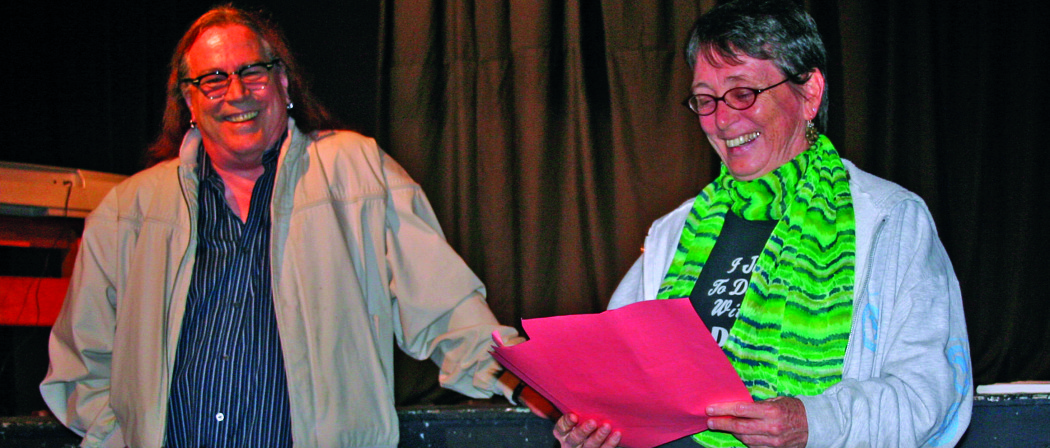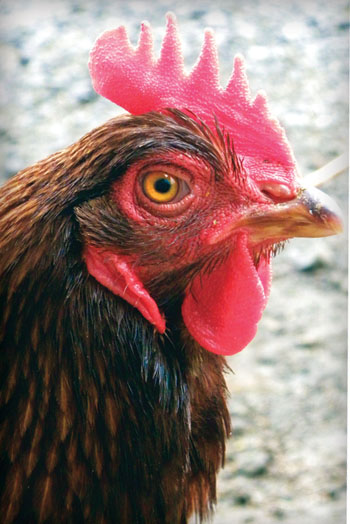
Suzi Bond Helps the Stars Shine in Volcano: The Executive Director of KDEN Likes a Challenge
 By Alan D. McNarie
By Alan D. McNarie
It’s a rainy November evening in Volcano. A small group of aspiring actors have gathered at the Kilauea Military Camp Theater (KMC) to try out for Kilauea Drama and Entertainment Network’s (KDEN) annual winter musical—this year, it’s “The Fantasticks.” Director Suzi Bond knows most of the people here; they’ve worked with her on other productions. Pedro Ka’awaloa leads the group in a series of warm-up exercises, including musical scales and tongue twisters (“Say ‘rubber baby buggy bumpers’ five times”). Then each would-be performer sings a musical number while Bond watches from the second row of the auditorium; it’s all pretty pro forma, since she already knows what most of them are capable of.
Then a young, local woman takes the stage. She’s a little nervous at first; her body is stiff and her voice is tentative, a little breathy. But she gradually relaxes into the music; her voice gets stronger, her body swings into the rhythm. By the time she finishes, she’s not just singing the song, she’s radiating it.
The other performers break into applause, and Bond joins in.
Over the decades, she’s seen a lot of moments like that, both in adults and kids.
“In the beginning they’re looking at the floor and they can’t look up,” she remarked earlier, at a café in Volcano. “To watch them blossom to the point where at the end of the show they’ve got their faces up and they’re singing into the audience is just magically rewarding.”
Bond has been a driving force behind East Hawai‘i’s community theater scene for just about as long as anybody involved in it can remember. For years, she was performing arts coordinator for Volcano Arts Center, and produced Volcano’s annual summer musicals. When VAC decided to drop the musicals, Bond rounded up a few friends and benefactors and formed a non-profit theater company to keep the tradition alive. The result was KDEN, which started with a road production of Man of La Mancha in 2002.
“It was another one of those challenge things,” she recalls. “You tell me, ‘You can’t do it,’ and I automatically need to try it. I was told I couldn’t take a show on the road and not lose money, so I said, ‘Watch me.’”
In the nearly ten years since then, the company has steadily cranked out quality productions, mainly of classic musicals and operettas: Kiss Me Kate; Joseph and the Amazing Technicolor Dreamcoat; Bye Bye Birdie; You’re a Good Man, Charlie Brown, and lots and lots of Gilbert and Sullivan, the great Victorian writers of comic operettas.
“Probably my legacy after all of this is said and done, is that I brought Gilbert and Sullivan back to the Big Island. There’d been no G-and-S in 15 years before Pirates of Penzance in 2004,” she muses. Since then, the company has mounted The Mikado, H.M.S. Pinafore and Patience.
“The plan is to do all of the Gilbert and Sullivans before I die, or until they kill me,” she says. “I love the music, I love their tongue-in-cheek attitude towards society in general, and each show has turned out to be as relevant to today as it was originally.” She notes that Patience, for instance, “is talking about the aesthetic movement of the 1880s and it’s equivalent to the rock stars today. They [the show’s cast] didn’t get it until I told the them, ‘Think of Bunthorn as Justin Bieber.’”
Bond is a walking paradox, a diminutive, sleepy-eyed dynamo who manages to be both low-key and high-energy at the same time. She’s a self-described “massive multi-tasker” who usually has at least a couple of projects going at once. In addition to her KDEN productions, she works on productions for other theater companies and coordinates concerts and events.
“I’ve worked concerts like Heart, the Eagles, Jimmy Buffet, Olomana, Rap, Andy Bumatai, Kalapana…. I’ve done weddings, funerals; I’ll coordinate any event. The only thing I’m not allowed to coordinate is Thanksgiving dinner, and that’s up to my baby sister.”
Every Friday, she drives from her home in Lower Puna up to Volcano to teach theater at the Volcano School of Arts and Sciences. On Wednesdays, she makes the trek up again, to practice with the Volcano Festival Chorus.
She’s a past master of what she says “we used to call Guerilla Theater. This is what we have and this is what we need. How do we create this from this? You learn to be extremely creative with aluminum foil and pie tins and coffee cans…. The building would say that it had a 10-foot ceiling and it really wasn’t, but your sets were, so you’d have to adjust and do things at a slant.”
She did productions in the Aloha Theater in South Kona in the 1970s, before the wiring was fixed, and had to worry about throwing a random switch and having the whole theater go dark. She mounted a production of Peter Pan in the KMC Theater: “The theater has 11-foot ceilings, so you can’t fly anything there, and yet we flew people there for Peter Pan, because we were crazy.”
Bond grew up on O‘ahu, and was exposed to the arts early on. One of her grandmothers, Anna Charlotte Derby, was instrumental in starting the Honolulu Academy of the Arts. The other, Dora Cooke Derby, was a founder of the Honolulu Symphony and took her to performances. “Grandma Derby” also taught Bond to sew.
“While we were sewing, she’d be playing records and classical music would be on…,” she recalls. “Thank you, Grandma. Sewing has saved my life more than once, financially.”
At 15, she got involved with the Diamond Head Community Theater.
“For the theater’s 90th anniversary, there were a whole lot of pictures,” she recounts. “In one of them, standing on top of a truck of junk that we were tossing from the theater at the time, was a very cute, skinny young girl. I stared at the picture for a long time, and then thought, ‘Oh, my God, it’s me.’ My next thought was, ‘I want that body back.’”
That skinny girl quickly learned that theater was about a lot more than acting, and set about becoming a jack-of-all-theater-trades. She put her sewing skills to work in the costuming department. She built sets and props and learned directing. She mastered the art of lighting.
“The first light board I ever worked, each dimmer was a big handle—36 dimmers on one wall—and you had to work it with two hands and one foot,” she recalls. “I remember doing one light cue where the top of my foot was under one dimmer, my knee was under another, I had both hands on dimmers and I was pushing one with the top of my head. Now you push a button and poof!” But computerized lights, she notes, have their own challenges. “Now with computers, it’s so sophisticated that if something goes wrong, you have to shut down the whole thing. You can’t go back, basically. It only moves forward…. I wanted to have one moment when the lights could fade by pools, and they couldn’t do that for some reason. It had to be programmed a certain way or it just wouldn’t run. It’s one of those cases where computers couldn’t make it better.”
In 1986 she decided to try her luck in Hollywood. She worked on a few movie productions, including Rob Reiner’s “The Big Picture.” Then she got a job at a post-production company and also started “a referral service for people in the production industry.” She got married and had her son Stephen. Then, in 1993, “I came home because I wanted to raise my son in Hawai‘i.”
Tragedy struck the next year, when Stephen’s father died. Bond got the job at Volcano Art Center so she could support her son and her beloved craft at the same time.
“I’ve liked the Big Island since I was a little girl, and I still like it,” she says. “For me, I’m the perfect-sized fish in my pond. I’m not so big that people are attacking me, but I have enough face recognition that people say, ‘I know you.’ People know me and know my work and respect the quality of my work enough that they come and see a show because my name is on it. I like that. It may sound conceited but I do.”
Among the great rewards of her life has been the many children that she’s introduced to the theater.
“Since I started working at the Volcano Art Center, I’ve probably touched the lives of at least 500 kids. I like it when they come up and hug me at the mall,” she says. She notes that some of her protégés have “gone on to major in music for autistic kids and theater with special needs kids, and that really makes me proud.”
The teaching she does at Volcano School of Arts and Sciences, she says, “is almost as important as the theater is to me. That program culminates in a night of play performances by the kids. But it’s not just about teaching theater, she says. “It’s about giving them the confidence so that when they stand in front of a group, they don’t have to think about the group but they can think about what they’re saying.” ❖
Contact writer Alan D. McNarie at amcnarie@yahoo.com.
Kilauea Drama and Entertainment Network website: KDEN.org


